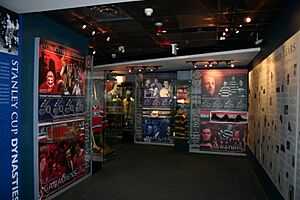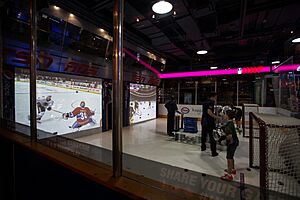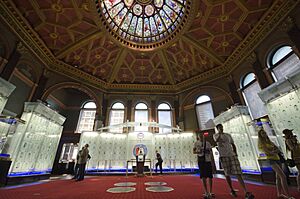Hockey Hall of Fame facts for kids
| Temple de la renommée du hockey | |
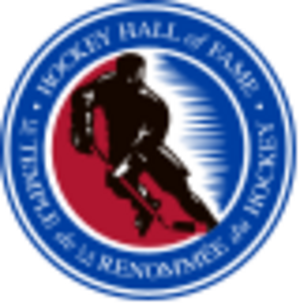 |
|
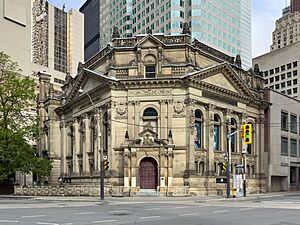
The Hockey Hall of Fame building in Toronto, from Front and Yonge Street
|
|
| Established | 1943 |
|---|---|
| Location | 30 Yonge Street Toronto, Ontario M5E 1X8 |
| Type | Ice hockey hall of fame and museum |
| Visitors | 292,000 |
| Founder | James T. Sutherland |
| Public transit access | |
| Inductees | 299 players 115 builders 16 on-ice officials 430 total |
The Hockey Hall of Fame (in French, Temple de la renommée du hockey) is a special museum and "hall of fame" in Toronto, Ontario, Canada. It's all about the exciting history of ice hockey. Here, you can find amazing exhibits about famous players, legendary teams, and incredible National Hockey League (NHL) records. You'll also see cool hockey items and all the important NHL trophies, including the famous Stanley Cup.
The Hockey Hall of Fame started in 1943, thanks to James T. Sutherland. The very first group of honored members joined in 1945, even before the Hall had its own building. It moved to Toronto in 1958 and opened its first permanent home in 1961. Later, in 1993, it moved to its current spot in downtown Toronto, inside Brookfield Place. Since 1998, it has also featured exhibits from the International Ice Hockey Federation (IIHF).
A group of 18 people, including players and coaches, meets every June to choose new members. These new members can be players, "builders" (like coaches or team owners), or on-ice officials. In 2010, a special group was created for female players. New members are celebrated at a ceremony in November, followed by a special "Hockey Hall of Fame Game" between the Toronto Maple Leafs and another team. As of May 2024, 430 people have been honored in the Hall of Fame.
Contents
History of the Hall of Fame
How it Started
The Hockey Hall of Fame began because of James T. Sutherland. He was a leader in Canadian hockey and wanted to create a place to honor great hockey players. He thought it should be in Kingston, Ontario, because he believed hockey started there. In 1943, the NHL and another hockey group agreed to create the "International Hockey Hall of Fame." Its goal was to celebrate hockey heroes and raise money for a building.
The first nine honored members joined on April 30, 1945. These included famous players like Georges Vezina and Howie Morenz. But at that time, the Hall of Fame still didn't have a permanent home.
Moving to Toronto
James T. Sutherland passed away in 1955. By 1958, the Hall of Fame in Kingston still hadn't raised enough money to build its museum. So, Clarence Campbell, who was the President of the NHL, decided to move the Hall to Toronto. In January 1958, the NHL and the Canadian National Exhibition (CNE) agreed to build a new Hall of Fame in Toronto.
A temporary Hockey Hall of Fame exhibit opened in August 1958. It was part of Canada's Sports Hall of Fame at Exhibition Place. Many people visited it, so the NHL and CNE decided to build a permanent home there. Construction started in 1960.
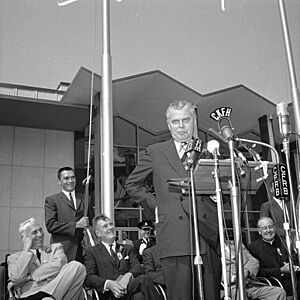
The first permanent Hockey Hall of Fame building opened on August 26, 1961. The Canadian Prime Minister, John Diefenbaker, was there for the opening. Over 750,000 people visited in the first year! For many years, it was free to visit.
A New Home Downtown
By 1986, the Hall of Fame needed more space. So, they decided to find a new home. The Hall left the Exhibition Place building in 1992. Its new location was in downtown Toronto, at Brookfield Place. This new building was much bigger, with about 4,700 square meters (50,000 square feet) of exhibit space. The new Hockey Hall of Fame officially opened on June 18, 1993.
How the Hall of Fame Works
The Hockey Hall of Fame is run by a team of dedicated people. The current curator, who helps manage all the exhibits and artifacts, is Phil Pritchard. The Hall of Fame is led by Lanny McDonald, who is the Chairman of the Board, and Jeff Denomme, the Chief Executive Officer. It operates as a non-profit organization, meaning it uses its money to keep the museum running and improve its exhibits. Most of its money comes from people visiting the museum.
Amazing Exhibits to Explore

The Hockey Hall of Fame has 15 different areas to explore, covering a huge space. You can see famous trophies, special items, and even equipment worn by players during important games.
The Esso Great Hall
This area is like a "Cathedral to the icons of Hockey." It has pictures and information about every person honored in the Hall of Fame. The most important item here is the Stanley Cup itself! For part of the year, a copy is on display while the real Cup travels. The original Stanley Cup and all the other current NHL trophies are kept safe in a special bank vault area.
NHL Zone
The NHL Zone is a big area all about the National Hockey League.
- NHL Today: Shows current teams and players.
- NHL Retro: Has items and information about all NHL teams, past and present.
- NHL Legends: Features changing exhibits about honored members.
- NHL Milestones: Displays amazing records, like Wayne Gretzky's all-time points record.
- Stanley Cup Dynasties: Shows items from nine teams that were so good they dominated the NHL for many years. You can even see a copy of the Montreal Canadiens' old dressing room!
The St. Louis Bar and Grill Arena Zone is about hockey at all levels in North America. It includes exhibits about different leagues, women's hockey, and hockey for people with disabilities. This area now has trophies from many North American leagues, items from the original six NHL arenas, and a full-size Zamboni machine!
Interactive Fun
In the NHLPA Be A Player Zone, you can get in on the action!
- NHLPA Gametime: You can take shots with real pucks at a computer goalie, Ed Belfour.
- Goaltender Challenge: Try to block shots from computer versions of players like Sidney Crosby and Wayne Gretzky.
- TSN/RDS Broadcast Zone: Learn how hockey is broadcast and even record your own message!
World of Hockey Zone
While many exhibits focus on the NHL, there's a large area dedicated to hockey around the world. The World of Hockey Zone opened in 1998. It's a big area that celebrates international hockey, including the World Championships and Olympic competitions. It has information about all the countries that are part of the International Ice Hockey Federation (IIHF).
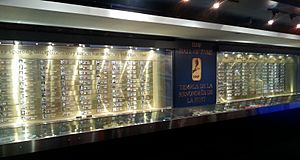
This zone includes the IIHF Hockey Hall of Fame honor roll, listing members by country and year. You can see many national team hockey jerseys and items from the "Miracle on Ice" at the 1980 Winter Olympic Games. Other important events featured are the 1972 Summit Series, and various European hockey leagues.
A new part of the World of Hockey is "Women's Hockey: Celebrating Excellence." This exhibit explores the history of women's hockey, from its early days to the PWHL.
Becoming a Hall of Famer
How Members are Chosen
New members can join the Hockey Hall of Fame as players, "builders," or on-ice officials. The "builders" category includes people like coaches, general managers, team owners, and others who have helped grow the game. The category for on-ice officials (referees and linesmen) was added in 1961.
Candidates are nominated by an 18-person committee. This committee includes Hall of Fame members, hockey experts, and media personalities from around the world. Each committee member can nominate one person in each category every year. The committee meets in June and votes in secret. To be inducted, a person needs 75% of the votes.
A maximum of four players, two builders, and one on-ice official can be inducted each year. Players and on-ice officials must have stopped playing or officiating for at least three years to be considered. Builders can be active or retired.

In the past, the waiting period was sometimes waived for very special players like Wayne Gretzky. However, after Gretzky's induction in 1999, the Hall decided this would rarely happen again. Some Hall of Fame members, like Gordie Howe and Mario Lemieux, even came out of retirement after they were inducted!
In 2010, new rules were added. Now, male and female players are considered separately, and up to two women can be inducted as players each year.
Media Honorees
There are also special awards for people in hockey media. The Elmer Ferguson Memorial Award goes to newspaper writers, and the Foster Hewitt Memorial Award goes to radio and television broadcasters. These honorees are celebrated with a display at the Hall of Fame, but they are not considered full inductees.
Induction Ceremony
The induction ceremony, where new members are officially welcomed, has been held at the current Hall of Fame building since 1993. Since 1999, there's also been a "Hockey Hall of Fame game" between the Toronto Maple Leafs and a visiting team. A special ceremony honoring the new inductees happens before this game.
Images for kids
-
A gold medal awarded to Angela James, a Hockey Hall of Fame inductee, on display at the Hall of Fame
-
Curtis Joseph's jersey from the 2001 Hockey Hall of Fame game, displayed at the Hall of Fame entrance inside Brookfield Place


